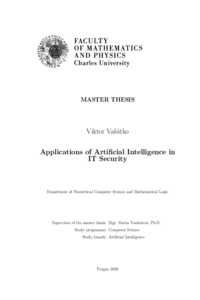Aplikace umělé inteligence v IT bezpečnosti
Applications of Artificial Intelligence in IT security
diplomová práce (OBHÁJENO)

Zobrazit/
Trvalý odkaz
http://hdl.handle.net/20.500.11956/119566Identifikátory
SIS: 206254
Kolekce
- Kvalifikační práce [11978]
Autor
Vedoucí práce
Oponent práce
Neruda, Roman
Fakulta / součást
Matematicko-fyzikální fakulta
Obor
Umělá inteligence
Katedra / ústav / klinika
Katedra teoretické informatiky a matematické logiky
Datum obhajoby
8. 7. 2020
Nakladatel
Univerzita Karlova, Matematicko-fyzikální fakultaJazyk
Čeština
Známka
Výborně
Klíčová slova (česky)
strojové učení, bezpečnostKlíčová slova (anglicky)
machine learning, securityCílem této práce je prozkoumat problematiku detekce útoků na počí- tačové systémy a vytvořit jednoduchá pravidla, která jsou schopna detekovat jednotlivé útoky. Útoky jsou prozkoumány na realistickém datasetu CSE-CIC- IDS2018. Nejprve se práce zabývá analýzou datasetu. V analýze jsou spočítány různé statistiky datasetu a na závěr jsou otestované různé metody redukce di- menzí pro zobrazení dat v dvou demenzionálním prostoru. Po analýze následuje příprava a normalizace dat. Proces trénování se pak zaměřuje na výběr vhod- ných příznaků a hledání nejlepšího modelu. Stejné příznaky jsou pak použity i pro vytváření pravidel. Pravidla jsou extrahována ze souboru rozhodovacích stromů. V závěru práce jsou pravidla porovnána s nejlepším modelem. Ex- perimenty ukazují, že jednoduchá pravidla jsou schopna dosáhnout podobných výsledků jako nejlepší model. Mohou být použita v pravidlových systémech pro detekci útoků nebo nasazena jako jednoduchý model. 1
The objective of this work is to explore the intrusion detection prob- lem and create simple rules for detecting specific intrusions. The intrusions are explored in the realistic CSE-CIC-IDS2018 dataset. First, the dataset is analyzed by computing appropriate statistics and visualizing the data. In the data visu- alization various dimensionality reduction methods are tested. After analyzing the dataset the data are normalized and prepared for the training. The training process focuses on feature selection and finding the best model for the intrusion detection problem. The feature selection is also used for creating rules. The rules are extracted from an ensemble of Decision Trees. At the end of this work, the rules are compared to the best model. The experiments demonstrate that the simple rules are able to achieve similar results as the best model and can be used in a rule-based intrusion detection system or be deployed as a simple model. 1
